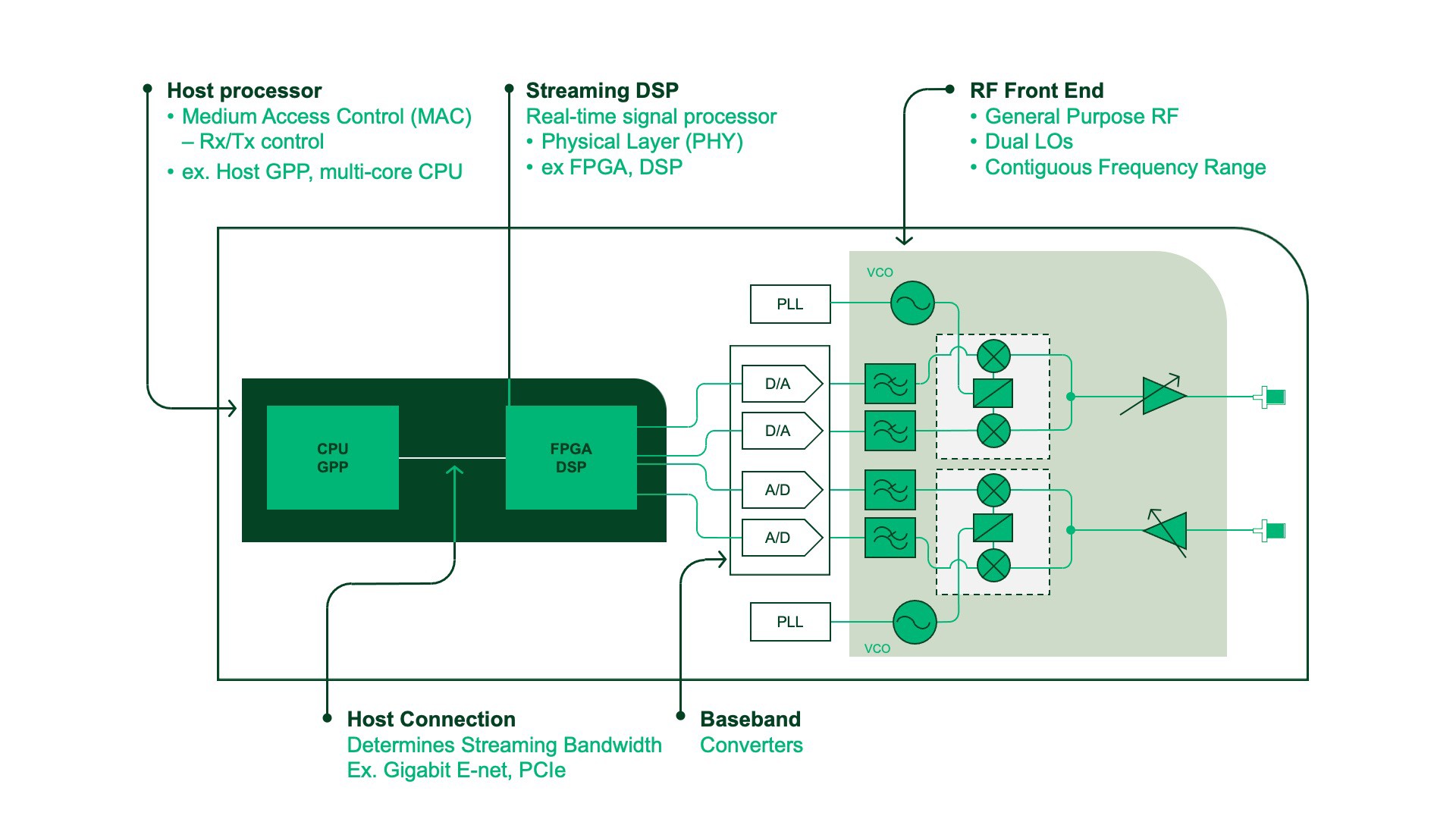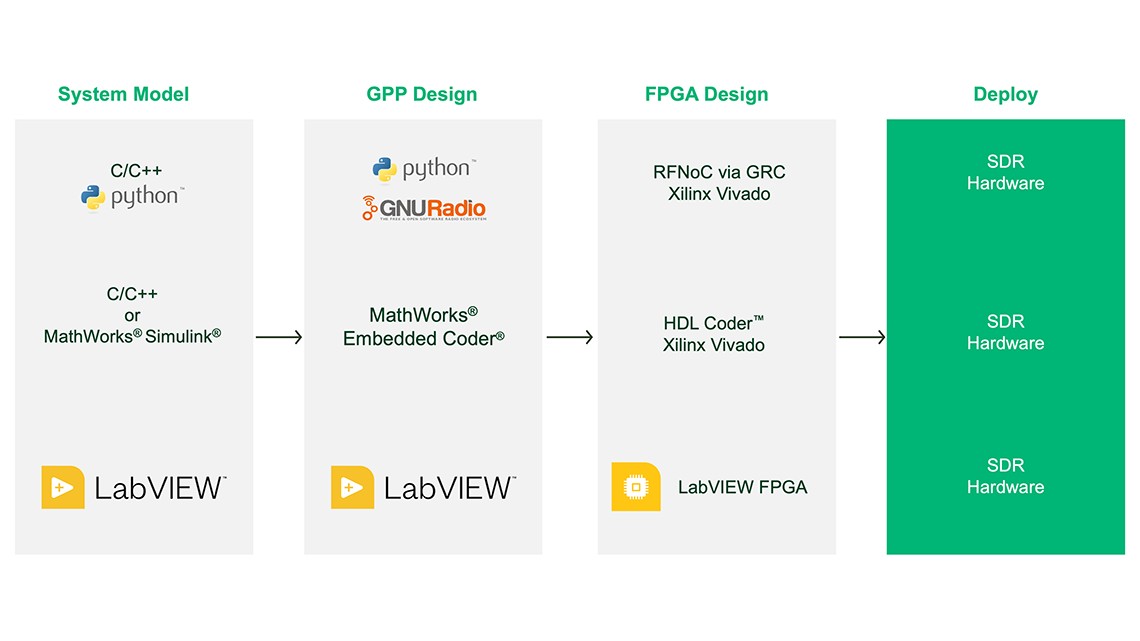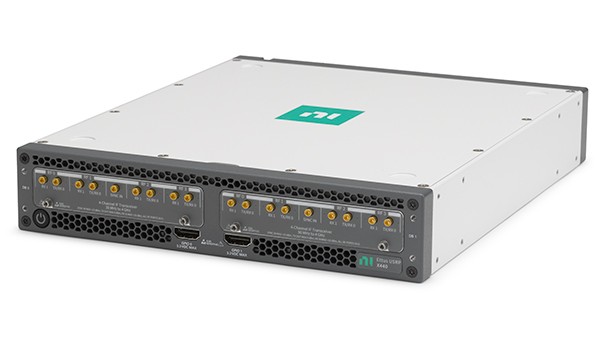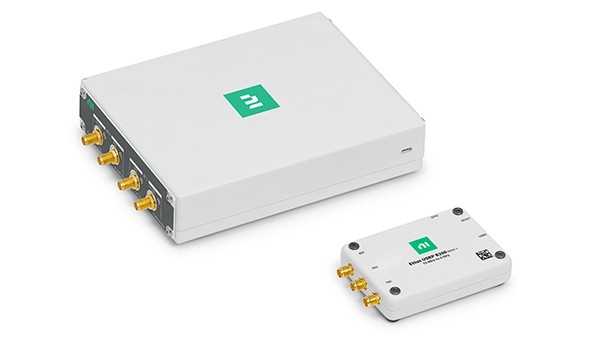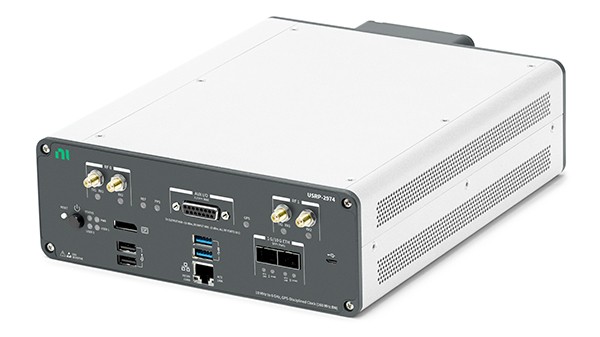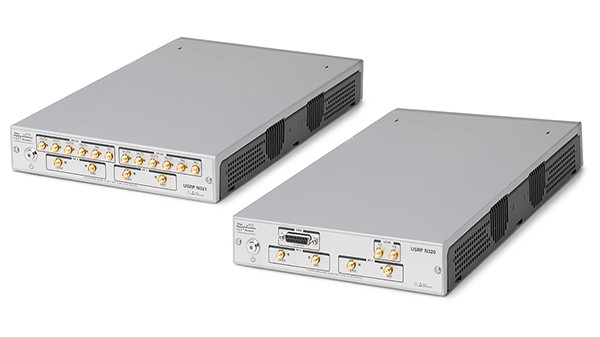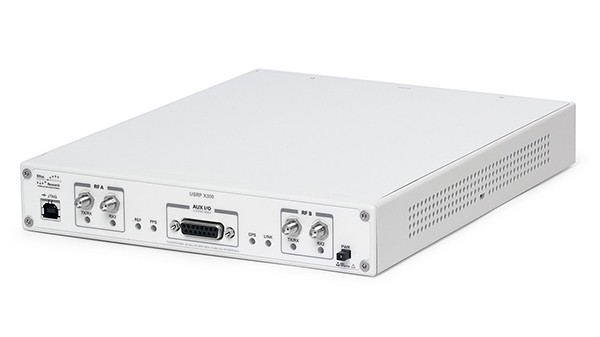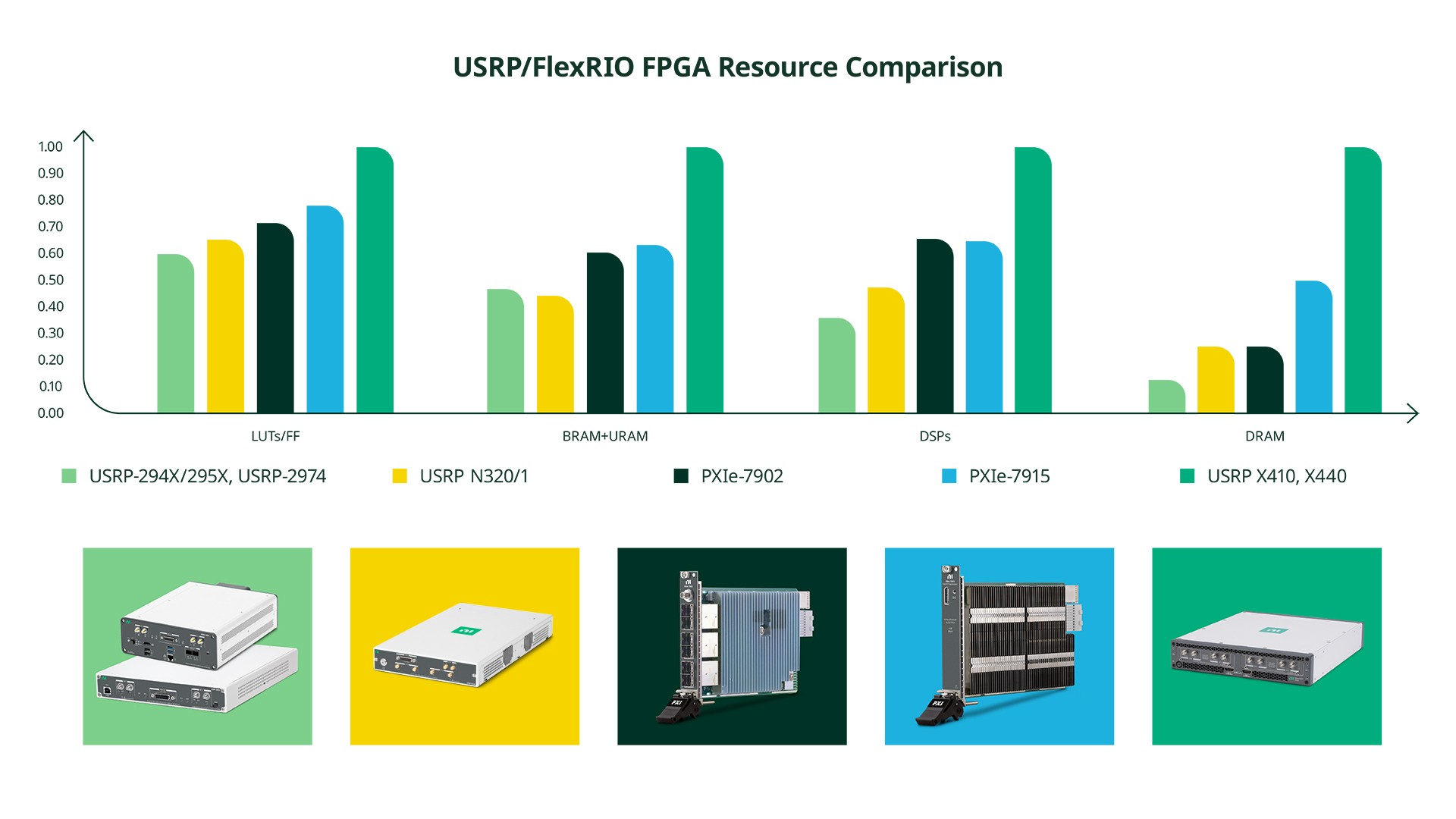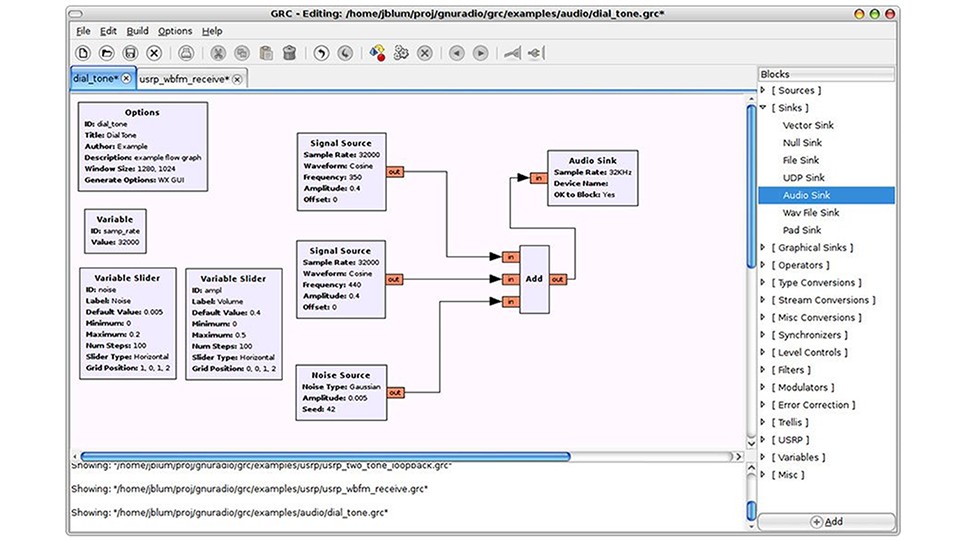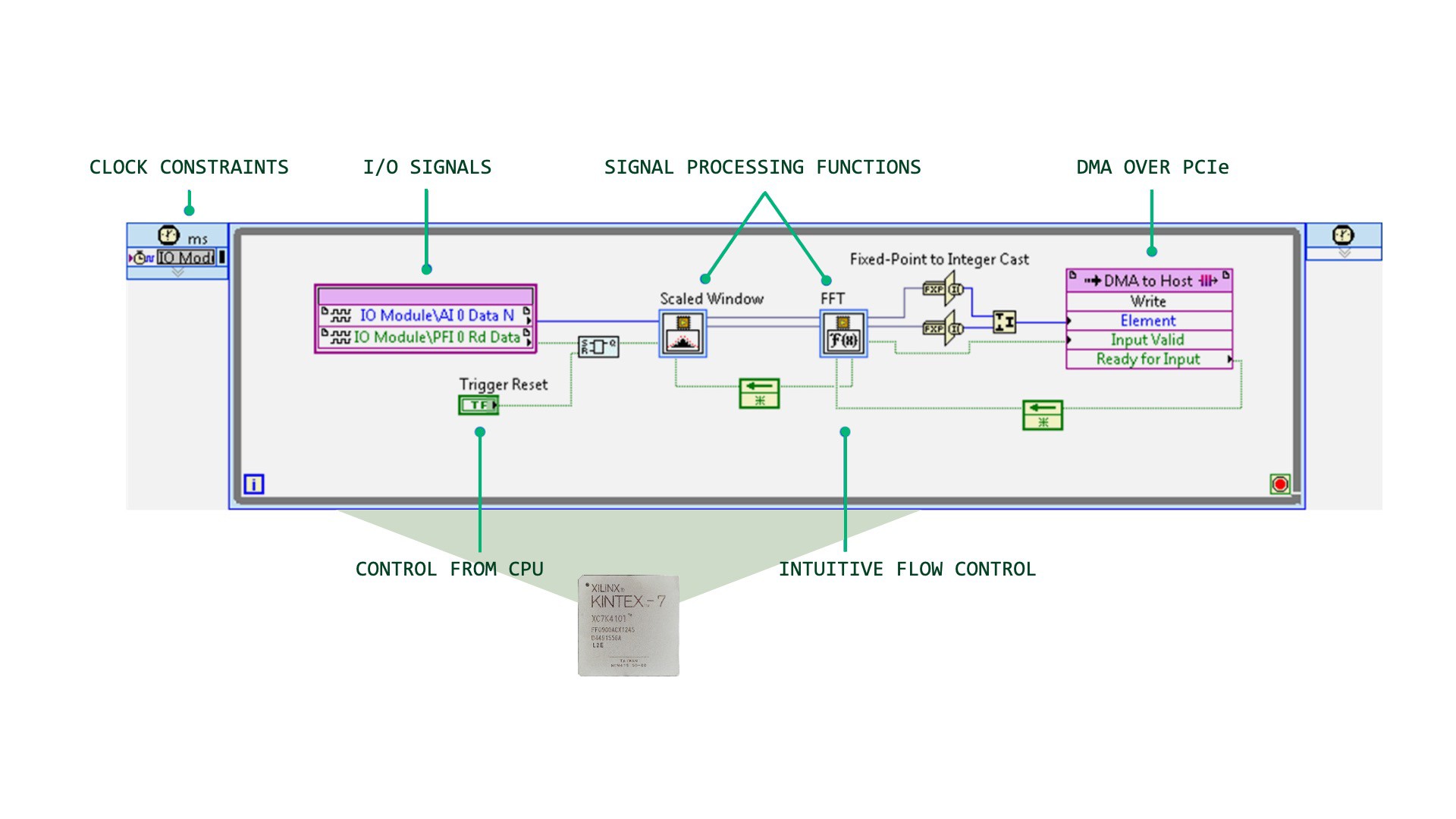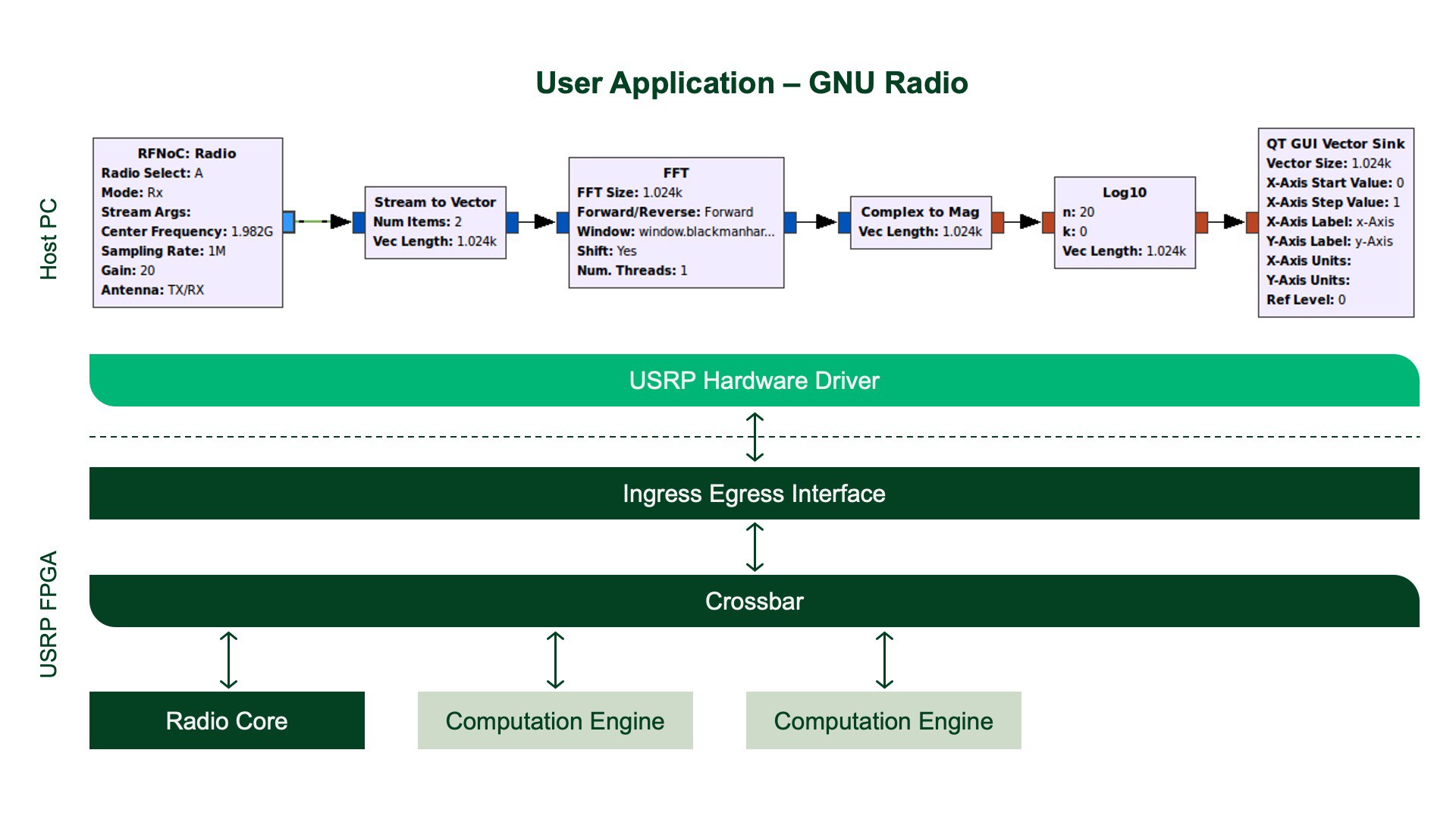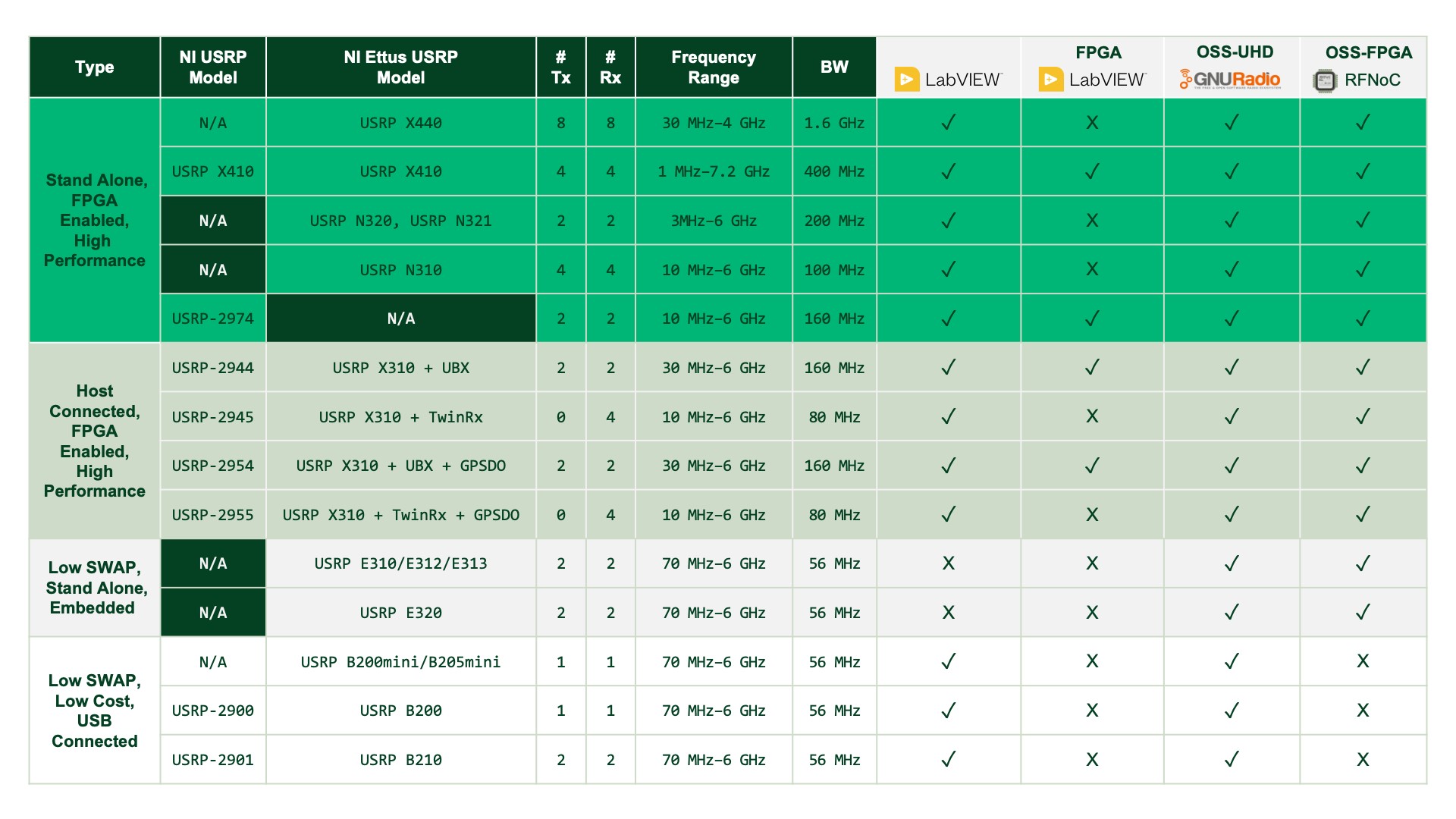Which USRP Is Right for You?
Overview
If you’re planning to develop a wireless application and need to select a software defined radio (SDR), you may have a few questions, such as:
- Where do I start?
- Which Universal Software Radio Peripheral (USRP) is right for me?
- What software development tool should I use?
This white paper explains the key differences between various USRP models and can help you select the right radio.
Contents
Software Defined Radio Introduction
Software defined radios are wireless devices commonly used for wireless research prototyping and deployed applications. SDRs are commonly used for communications, next gen radar, EW, over-the-air (OTA) test, and 5G research. Most SDR have a common hardware architecture including general purpose processors (GPPs), FPGAs, and RF front ends of varying performance.
Figure 1: Typical Hardware Architecture of an SDR
For host application code development, engineers use these common tools:
- LabVIEW
- C/C++ or Python with open-source hardware drivers
- Open-source SDR frameworks like Redhawk or GNU Radio
- MathWorks® MATLAB® software and Wireless Testbench™ software
The software development tool and operating system can determine which radio is ideal for your application.
Many applications require signal processing hardware acceleration with an FPGA device. Several USRPs offer this capability, and there are many options for FPGA development, as discussed later in more detail.
Figure 2 depicts an overview of common tool flows for software and FPGA development available on the USRP.
Figure 2: Software and FPGA Options for SDRs
The NI and Ettus Research Universal Software Radio Peripheral (USRP) products are a family of software defined radios designed to meet the wide range of wireless prototyping and deployment requirements. Let’s explore the various hardware and software considerations to help you choose the right radio.
Hardware Options
When choosing the right USRP device for your application, a good place to start is by asking yourself a few questions related to signal parameters, size, weight, power, cost (SWaP-C), performance, and environmental application requirements. Question one: What center frequency and bandwidth do I require?
This question is easy enough to answer, but the next one is more involved: How do I plan to move signal data on or off the device?
This brings into focus the importance of data interfaces. For example, the USRP-290x models are connected to the host through USB and are limited by the maximum sustained bandwidth of that interface, whereas the Ettus USRP X440 is equipped with two 100 GbE interfaces capable of moving much more data.
To learn more about USRP interface bandwidth considerations, read about USRP Bandwidths and Sampling Rates on the Ettus Research knowledge base.
Most USRP devices have a maximum frequency up to 6 GHz and some higher; however, the NI Ettus USRP X410 can operate in the 7 GHz band. On the lower frequency end, some radios go down to 75 MHz and some as low as DC depending on the analog chipset used. See Figure 16 for a breakdown of each model.
Figure 3: The Ettus USRP X410, built on an RFSoC, is a high-frequency wideband SDR with a center frequency up to 7.2 GHz
Cost and Performance Trade-offs
There are trade-offs to consider when choosing a USRP device, specifically cost versus performance. If you require a radio at a great value and you do not have advanced FPGA or wide bandwidth requirements, the NI USRP 290x or Ettus Research B200mini are great options. If you need the widest bandwidth and frequencies up to 7.2 GHz, the NI Ettus USRP X410 may be the best fit. There are many options available in between these two examples. Figure 15 below gives a full break down across all models.
Figure 4: USRP B200 and USRP B200mini Low SWaP-C SDRs
If you need frequencies up to 7.2 GHz, the NI Ettus USRP X410 may be the best fit. If you require the widest possible instantaneous bandwidth, the NI Ettus USRP X440 may meet the need. There are many options available beyond these examples; Figure 16 provides a full breakdown across all models.
Figure 5: The Ettus USRP X440 offers up to 1.6 GHz bandwidth per channel, with a direct sampling transceiver architecture
Stand-Alone or Host-Connected SDR Options
The USRP was conceived as a computer peripheral to connect software to the electromagnetic spectrum. Applications have evolved since the first USRPs, and many require an embedded processor onboard. You may require this stand-alone configuration if your application has the SDR physically distributed from a centralized control system or deployed on its own. If stand-alone is a key requirement, you will need to decide if a Xilinx Zynq™ Multiprocessor System on Chip (MPSoC) or RF System On Chip (RFSoC) is sufficient or if you require a powerful Intel X86 processor onboard. Table 1 provides a breakdown of various models and their onboard processors; consult USRP specification documents for more details.
| Radio Model | Onboard Processor |
|---|---|
| USRP N320, USRP N321, USRP N310 | Xilinx Zynq 7100 MPSOC |
| USRP E31X | Xilinx Zynq 7020 MPSOC |
| USRP E320 | Xilinx Zynq 7045 MPSOC |
| NI Ettus USRP X410, USRP X440 | Xilinx Zynq Ultrascale+ RFSOC ZU28DR |
| USRP 2974 | Intel Core i7 6822EQ (2 GHz Quad Core) |
Table 1: Stand-Alone Capable USRP Models with Onboard Processors
Figure 6: USRP 2974 Stand-Alone SDR with Built-in Intel Core i7
Ruggedization and Harsh Environments
Although many USRPs are used in the lab, some applications require operation in outdoors or in harsher environments. If your application requires extended operating temperatures or can’t rely on air-cooling, you may want to consider the Ettus Research branded Embedded Series for your application. Additionally, under the Ettus Research brand, there are options to configure the USRP B205mini for extended temperature range with the use of the industrial grade aluminum enclosure assembly for low SWaP operation. Alternatively, if you have extreme environmental requirements, we would love to connect you with our experienced ruggedization partners; contact us to explore these options.
Figure 7: Embedded Series, USRP E320
Multichannel Synchronization
Many applications require multiple input and multiple output (MIMO) configurations with varying levels of synchronization. Some MIMO systems simply require a shared clock for ADCs and DACs, while others require every channel to be locked to a common clock and local oscillator for a full phase coherent operation.
A common MIMO application is for communications with spatial multiplexing. As this only requires clock synchronization, most USRPs with an external 10 MHz reference clock will be sufficient. An example of such a system was built by The University of Bristol and Lund University when they broke the wireless spectral efficiency world record using an SDR-based massive MIMO system. The system used in this application is composed of NI USRP Software Defined Radio Devices with onboard FPGAs.
Figure 8: USRP N320 and N321 with Built-In LO Distribution Interfaces
When a full phase coherent operation is required, you have a few options to consider. If you require up to four channels of receive only operation, the Ettus Research USRP X310 with two TwinRx daughterboards can be set up to share the LO and operate in a phase coherent manner. If more than four channels are required, then consider the Ettus Research USRP N320 and N321 (shown in Figure 8) or the NI Ettus USRP X440. Since the USRP X440 is built with a direct-sampling intermediate frequency (IF) architecture, synchronization can be achieved by sharing sample clocks across up to eight transmit and eight receive channels. It is prepared for multidevice synchronization to an externally provided reference clock signal.
The USRP N321 comes equipped with built-in LO distribution hardware allowing for up to 128 x 128 phase coherent operation: a 32 x 32 configuration example is shown in Figure 9.

Distributed Multi-Radio Synchronization
In some applications, radios require synchronization but are not co-located. In these instances, a full phase coherent operation is a challenge; however, one can use GPS-based synchronization to get frequency and phase stability with a GPS disciplined oscillator (GPSDO). Many USRP models are equipped with a GPSDO from the factory. To learn more, read “Global Synchronization and Clock Disciplining with NI USRP-293x Software Defined Radio.”
Figure 10: USRP X310 with Onboard GPS Disciplined Oscillator
Inline Signal Processing and FPGA Considerations
Some applications have processing requirements that are best suited for an onboard FPGA. These applications often have wide signal bandwidths or low/deterministic latency requirements. In these cases, picking a radio with the ability to program the FPGA is important. Many of the USB and lower-cost USRP models, such as the USRP B200mini or the N210, are built with smaller FPGA devices and as such do not have the space to add user code. Many of the higher end radios come equipped with Kintex 7 class devices all the way up to the state-of-the-art Ettus USRP X410 and X440 with the Xilinx Zynq UltraScale+ RFSoC. Devices built on Xilinx Zynq include additional cores such as onboard soft-decision forward error correction (SD-FEC), multi-Arm processors, and built-in ADCs and DACs.
| USRP Model | Onboard FPGA |
|---|---|
| USRP N320, USRP N321, USRP N310 | Xilinx Zynq 7100 MPSOC |
| USRP E31X | Xilinx Zynq 7020 MPSOC |
| USRP E320 | Xilinx Zynq 7045 MPSOC |
| Ettus USRP X410, USRP X440 | Xilinx Zynq Ultrascale+ RFSOC ZU28DR |
| USRP 2974, USRP X310 | Xilinx Kintex 7 410T |
Table 2: Comparison of FPGA Enabled USRPs
Figure 11: Comparison of FPGA Resources across NI FPGA Products
Software Options
Programmability is the key feature of an SDR, enabling one to take a radio peripheral and turn it into an advanced wireless system. The USRP is the most open and versatile SDR on the market, helping engineers to build systems with a wide variety of software development tools on both the host and on the FPGA.
Host Programming Considerations
As shown in Figure 2 above, there are a variety of options to program the host of an SDR-based system.
Programming on LabVIEW with NI-USRP Driver
LabVIEW is a graphical dataflow programming environment well-suited for designing and implementing communications algorithms. At the most fundamental level, LabVIEW uses the NI-USRP driver to both specify USRP hardware configuration and send and receive properly formatted baseband I/Q data ready for host-side signal processing.
If LabVIEW is your preferred development environment, it should be noted that although it does have some Linux-based OS support, it’s predominantly a Microsoft Windows-based tool. Additionally, some Ettus Research branded USRP models and configurations may not be supported; see Figure 16.
Figure 12: LabVIEW Block Diagram with the NI-USRP Driver API
Programming with Open-Source Workflows: USRP Hardware Driver (UHD) and GNU Radio
Many SDR users prefer to program USRP hardware with text-based and open-source tool flows built on C/C++ and Python. All NI and Ettus Research USRP models support the USRP hardware driver (UHD), allowing for easy integration to open-source community developed tools such as GNU Radio.
GNU Radio is an open-source tool built solely for SDR developers. While the USRP is not the only radio supported with GNU Radio, it’s the most popular and tested. To learn more about GNU Radio, visit gnuradio.org, and to see all the existing community shared IP for GNU Radio, visit cgran.org.
Figure 13: GNU Radio Companion Flow Graph
Programming with MATLAB
If MATLAB is your preferred tool for programming, several USRP models are supported with the MathWorks Communications Toolbox™. Supported models include, B200, B200mini, X300, N200, and N300 Series. In addition, engineers can directly embed MATLAB code into LabVIEW using the MATLAB script node.
MathWorks also offers Wireless Testbench, a tool that provides capabilities including intelligent signal capture and hardware-based resampling, leveraging the FPGA on the USRP software defined radio device. It allows users to specify waveform-specific characteristics to trigger signal capture and analyze the data of interest.
FPGA Programming Considerations
Many USRPs come equipped with a large FPGA with sufficient free capacity to allow users to embed inline signal processing specific to their application. As described in the hardware section, some USRPs come equipped with Xilinx Zynq SoC devices and some with traditional fabric FPGAs such as the Kintex 7. There are two ways to gain access to the FPGA on USRPs: LabVIEW FPGA and the RF Network on Chip (RFNoC) framework.
Unlike many FPGA development boards or COTS FPGA boards, USRPs are built on a common FPGA framework and provide a higher-level abstraction. This removes some of the complexity encountered when building an FPGA-based system from a bare-bones FPGA board support package.
LabVIEW FPGA
LabVIEW FPGA is an add-on extension for LabVIEW allowing for graphical programming of the FPGA on NI USRP RIO devices. Although one must be familiar with FPGA concepts such as fixed-point math and clocked logic, LabVIEW abstracts hardware and data interfaces and simplifies register configuration and data movement. An advantage of LabVIEW FPGA is the ability to program both the host and FPGA with a unified development tool chain.
Do you have legacy IP you’d like to leverage? LabVIEW FPGA can import external VHDL or Verilog through Component Level IP (CLIP) nodes, allowing for non-LabVIEW IP to be imported. Additionally, LabVIEW allows for Xilinx Vivado project export for expert users working within the Vivado tool directly.
If LabVIEW FPGA is your tool of choice for host programming, note that it is limited to Windows-based operating systems. Many Ettus Research devices such as the USRP N300 and USRP E300 series are not supported under LabVIEW or LabVIEW FPGA. See Figure 16 for a complete list.
Figure 14: Simple LabVIEW FPGA Block Diagram
RF Network on Chip (RFNoC) Framework
For open-source USRP users, the preferred way to program the FPGA is through the RFNoC Framework. RFNoC, like LabVIEW FPGA, is a data interface and command abstraction framework to simplify adding IP to your USRP without having to rebuild the entire FPGA board support package from scratch. As the name suggests, data flows through the FPGA from the radio as a compressed header network package. At the heart of the RFNoC framework is a crossbar interface allowing the user to simply plug new IP into the crossbar and route data to other IP blocks or to and from the host machine. This network crossbar design removes the complexity of passing data and commands to and from the host.
If working in Vivado and using RFNoC is your preferred path to program the FPGA of your USRP, consider the USRP X300 series, USRP E300 series, USRP N300, and the Ettus USRP X410 or X440 for your application. Learn more about how you can use RFNoC, UHD, and USRP N300 devices to prototype multichannel wireless communication systems.
Figure 15: RFNoC Conceptual Block Diagram Integrated with GNU Radio
Figure 16: NI and Ettus Research USRP Models Matrix
Conclusion
SDRs are powerful tools for wireless research, design, prototyping, and deployment. Many options exist, and choosing the right radio for your application has many considerations. However, with a careful assessment of the various software and hardware factors outlined in this white paper, you’re certain to work with the most popular open SDR on the market.
Next Steps
Embedded Coder® and MATLAB® are registered trademarks of The MathWorks, Inc.
Communications Toolbox™ and HDL Coder™ are trademarks of The MathWorks, Inc
